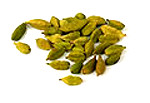10 must have spices in an Indian kitchen
January 15, 2013 The history of spices is as old as human civilization. In India, you will find a wide range of spices in every home. They form an inseparable part of every Indian kitchen. Each spice has its own aroma, flavor and medicinal value. Their healing properties rejuvenate the body. Indian traditions have long been utilizing various spices and there is a scientific basis to their use. Spices have tried, tested and trusted medicinal values and a profound effect on general health. They have a wide variety of biological functions and their cumulative or synergistic effects are likely to shield the body against a variety of ailments.
The history of spices is as old as human civilization. In India, you will find a wide range of spices in every home. They form an inseparable part of every Indian kitchen. Each spice has its own aroma, flavor and medicinal value. Their healing properties rejuvenate the body. Indian traditions have long been utilizing various spices and there is a scientific basis to their use. Spices have tried, tested and trusted medicinal values and a profound effect on general health. They have a wide variety of biological functions and their cumulative or synergistic effects are likely to shield the body against a variety of ailments.
There is a belief that spicy food is not healthy, but if you use fresh spices in your food then your skin will have a natural glow as spices also improve digestive processes by intensifying salivary flow, by cleaning the oral cavity and checking infections. Traditionally, spices used as part of the diet, have holistic effects on human health.
We are listing a few of the must have spices in your kitchen.
- Turmeric: It is an essential spice of every Indian food. It adds colour and flavor to your food and acts asa natural liver detoxifier.

- Dry Chilies: It is another spice that is mandatory in Indian foods. It is primarily used for tempering in dals along with Ginger and other spices.

- Ginger: It is a must in every Indian kitchen for not only cooking purposes but its medicinal properties. Ginger has a peppery and slightly sweet flavour and a pungent, spicy aroma. It is also used in making Hot Ginger Tea.

- PaanchPhoron: It is mostly used found in East Indian kitchens. Paanch meaning five and Phoron meaning tempering, so the spice is a combination of 5 essential spices needed for tampering. The mixture contains: Fennel Seeds (saunf), Cumin Seeds (Jeera), Nigella Seeds(Kaljeera), Fenugreek Seeds (Methi), Mustard Seeds. Some also like to add coriander seeds to the mixture for added flavor.

- Cumin: It can be used in the seed form or ground form. Cumin is used when highly spicy foods are preferred. It is an essential part of many curry powders and spicy mixtures.
- Chili Powder: Red chili powder is more complex than you might think. Usually a blend of dried chilies, garlic, cumin and oregano, it can also include coriander, cloves or pepper as well. Red chili powder is used to add color and hotness to your dishes. It is advisable to buy this spice from the open market where it is found fresh and in small amounts as it tends to deteriorate quickly. Store it in airtight containers in cool and dark place.
- Black Pepper: Also referred to as “king of spice”, this spice is a must in your kitchen. I always prefer black pepper when it comes to adding some heat to the recipe. Researches have shown that black pepper has fat fighting properties along with other medicinal properties.

- Coriander: Can be used in the leaf form or seed form or ground form of seeds. I particularly like it when added in leaf form in curries. It adds a special aroma to your recipes adding a smoky, solid base
- Garam Masala: Garam masala is a wonderfully aromatic blend of spices from India. Garam means “hot” or “heating” and masala means “spice blend”. The “hot” is not necessarily referring to the kind of heat we find in hot chillies but to the fact that the spices are first toasted then ground. It is being said that the amalgamated effect of the spices in garam masala increases body temperature, a pleasant warm glow you might feel after eating a dish flavoured with it.The recipe for the mixture differs from place to place and it may contain anything that adds heat but the most common being Cardamom, Clove and Cinnamon. When in ground form, some also add coriander and peppercorn.

- Bay Leaf: Last but not the least, bay leaf. It is known for its anti-diabetic properties. It adds a special aroma when added to curries.



It adds a special flavour to pili daal. You should try it someday.
I liked this one !
thanks for telling about PaanchPhoron
will keep it in my kitchen too